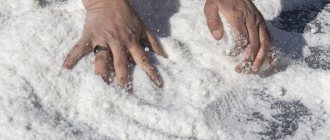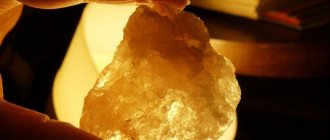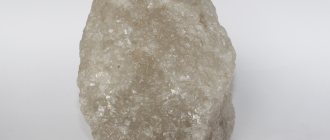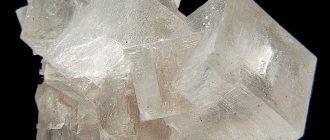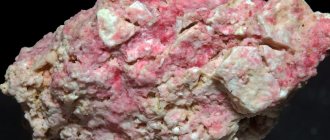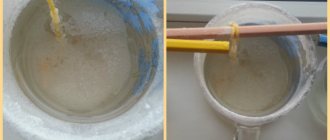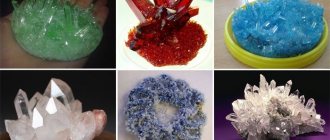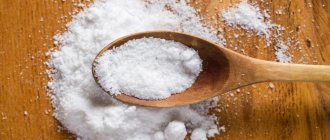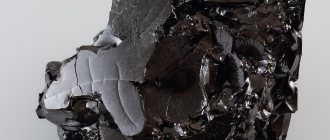Salt is a vital food product not only for humans, but also for all mammals. Without it, gastric juice is not secreted to digest food.
Therefore, even wild animals search for salt marshes. And herbivores eat hazel bark. In this tree and some others, salt is present in low concentrations due to the fact that the plant absorbs groundwater and deposits sodium chloride.
By the way, ancient hunters and herders sometimes ate raw meat for the same reason. After all, sodium chloride is also present in the blood of animals.
It has been six thousand years since man learned to extract salt. Now we see many types of these products on the shelves.
But if you don’t take into account salt with various additives, as well as colored salt (the crystals get their hue thanks to inclusions of minerals and clay), it is divided into only two types: table and sea. Which one should you choose?
Which type will bring the most benefit? What is the difference between sea salt and table salt? Our article is devoted to these issues.
The benefits and harms of salt
We have already said that sodium chloride is responsible for the production of acid in the stomach. Salt ions are essential for many body functions, including the transmission of nerve impulses from the brain to the periphery and muscle contraction.
Lack of salt in the body leads to increased fatigue, general weakness, muscle and nervous disorders. A deficiency of sodium chloride can lead to nausea, dizziness, and headache.
Therefore, so-called salt-free diets should be treated very carefully and practiced only under the supervision of a doctor. However, you should not overuse salt.
The optimal amount, according to doctors, is from four to six grams per day for a healthy adult. And this takes into account the fact that we consume salt in various products, from bread, where you can hardly feel it, to chips, feta cheese and fish snacks.
An excess of this substance in the body can lead to edema, fluid stagnation, increased blood and intraocular pressure, stomach cancer and cataracts. Now let’s take a closer look at sea salt and regular salt. What is the difference between them? Let's figure it out.
Himalayan pink
This type of salt is becoming increasingly popular. Fans of healthy eating appreciate it for its richness in useful elements: about 80 minerals with a total of 5%. The product looks attractive, has a slightly specific taste, so it is no longer used for salting food, but for decorating ready-made dishes and for cosmetic procedures. The pink color is due to the presence of iron oxide in the composition.
Pink salt is mined in Pakistan, in mines located 300 km from the foot of the Himalayas, which explains the name. The second place of production is the Crimean Peninsula.
Rock salt - what is it?
This type is the most ancient. And not only because humanity learned to mine rock salt eight thousand years ago.
The composition of this product is also very ancient. After all, what is so-called rock salt? These are crystals of sodium chloride, which were formed as a result of the drying out of ancient seas that splashed on our planet from hundreds to tens of millions of years ago.
Sometimes these deposits are very close to the surface of the earth, forming domes. But most often they are located very deep, and to extract them you need to dig mines.
Despite some difficulty in extraction, humanity became familiar with rock salt much earlier than with sea salt. Therefore, it is also called cookery (that is, kitchen, the one that is added to dishes) or regular.
But it is used not only for food, but also as a fertilizer and in cosmetology. But by and large, what is the difference between sea salt and regular salt? Origin? Not at all!
After all, table salt is also sea salt. It’s just that the oceans in which it was once dissolved dried up millions of years ago.
Kosher
The name of the product is not related to the eating habits of Orthodox Jews. The word “kosher” in this case does not mean “fit for food”, but “used for koshering,” that is, for special processing of meat to remove the blood remaining in the carcass. The meat is rinsed, soaked, then rubbed with salt.
Many cooks, especially in the West, use kosher salt. Its first advantage is that it has a less intense taste, so you don’t have to worry that too much will spoil the food product. The second advantage is the large size and special shape of the crystals, so it is convenient to rub it with your fingers over the meat. Third, rapid solubility.
Sea salt production
There is no need to talk about the origin of this type of sodium chloride. The name “sea” speaks for itself. Residents of the coasts with hot climates were the first to become acquainted with this type of salt.
It often happened that the sea filled small depressions during storms. In the heat these lakes dried up. The water evaporated, leaving shiny crystals at the bottom.
More than four thousand years ago, people thought of helping nature. In the south of France, Bulgaria, Spain, India, China, and Japan, they began to block off shallow water with dams, separating it from the rest of the water area. The hot sun completed the work.
In Foggy Albion, where there was little hope for light, water from the sea began to simply evaporate. But the inhabitants of the North took a different path.
It has been noticed that the freezing point of fresh water is 0 degrees, and salt water is slightly lower. When the liquid turns to ice, it separates.
A very saturated solution forms below. By separating it from fresh ice, the crystals can be evaporated with less energy consumption.
What distinguishes sea salt from regular salt is the extraction method. It is believed that in the first case it is evaporated, and in the second it is often mined with a pickaxe in mines. But is it?
Rock salt production
Halite is a mineral that is sodium chloride in the form of a druse (crystal), and is not found very often in nature. And the mines where miners descended to lift carts of salt up the mountain are rare.
That’s why they offer excursions to Wieliczka (Poland) and Solotvyno (Ukraine). A more ancient way to obtain rock sediment from ancient seas was to pour fresh water into a deep pit, wait until the mineral dissolved, then scoop out the liquid... and evaporate it all the same.
This is exactly how the product was obtained in the oldest known saltworks, Provadia-Solnitsata in Bulgaria. And this happened back in the sixth millennium BC!
Water from the salty spring was evaporated in ovens. They were made of clay and had the shape of a cone.
So is sea salt different from regular salt in terms of production method? As you can see, evaporation is used in the extraction of both types of product.
Of course, rock salt from the mines was not subjected to additional heat treatment. But this rarity was worth its weight in gold.
Where and how is salt mined?
Significant mineral deposits are located in Europe, South Asia and America. Important deposits in Russia:
- Iletskaya Zashchita - near Orenburg;
- Solikamsk - in the Perm region;
- Belbazhskoye field - in the Nizhny Novgorod region;
- Lake Baskunchak near the Volga.
Large deposits are located in Poland, Egypt, India, at the foot of the Himalayan mountains. To indicate deposits of stone halite on maps, it is customary to draw a white cube.
There are several ways to extract the mineral:
- mine - they lift whole monoliths from great depths;
- vacuum - fresh water is pumped into the well under pressure, then the saline solution is pumped out and the salt is evaporated from it;
- evaporation – seawater is taken and evaporated to produce salt and fresh water.
Salt production is one of the most significant areas of industry. About 100 million tons of rock salt are used worldwide every year.
In addition to the topic, video:
The myth about the uniqueness of sea salt
Modern marketing gives us the idea that sodium chloride extracted from the ocean is much more valuable in chemical composition than that obtained from land deposits. They say that sea water contains more minerals, including iodine.
It's time to debunk this myth. How is sea salt different from regular salt? Composition? Analysis shows that in both cases we are dealing with ordinary sodium chloride.
Since the culinary product was formed on the site of dry oceans, it contains the same composition of minerals as sea water. Moreover, iodine is a volatile substance. It is the first to evaporate during thermal treatment of seawater.
The remaining 75 elements, which modern marketers and advertising producers trumpet so much about, remain in the sludge, which is carefully separated from the resulting salt during evaporation. After all, the buyer wants to get beautiful white crystals, and not a gray mass.
Therefore, sea salt, like purified table salt of the “Extra” class, is sodium chloride and nothing else. The remaining impurities are in such insignificant quantities that they are not worth talking about.
Marine
The second most popular type of salt. It is obtained either by evaporation of sea water, or from shallows during a natural decrease in sea level. The composition contains 2% minerals beneficial to humans, including iron, potassium, zinc. The taste of the sea variety is almost no different from the table variety, except perhaps less rich. Recommended for preparing fish dishes and baking.
The peculiarity of sea salt is the variety of shades of crystals: from faded gray to pinkish. The color of the product is determined by the conditions of formation on the seabed: the type of clay substrate and the color of underwater vegetation.
Second myth: sea salt is the purest
Sometimes advertising producers contradict each other. Thus, some of them claim that the difference between sea salt and table salt lies precisely in its purity.
They say that the stone product contains many impurities left over from the silt of dried up ancient oceans. This is all true, except for one small detail. Rock salt also undergoes purification.
Raw blocks are used for the needs of the chemical industry, for the production of glue, fertilizers, etc. If the halite druses are without impurities, they simply break up.
All the rest are purified by turning them into a solution - brine and further evaporation. Because of this, there are different grades of salt - from the highest, “Extra”, to the third.
As for “harmful” impurities, they can be present in both stone and marine products. This is potassium ferrocyanide, a substance designated as E536 in the international coding system.
It is added to prevent salt crystals from caking. And an impurity that will certainly be beneficial for the body is iodine.
Black salt
This type of salt is less popular in Russia compared to others. However, black salt is considered a common and healthy seasoning in many countries and peoples.
It is mined in places where hydrogen sulfide is present. Salt goes on sale in almost unrefined form. According to scientists, it is safer and healthier for the body due to components that improve digestion.
Photo: istockphoto.com
Black salt helps increase appetite, eliminates constipation and flatulence. However, it should not be confused with Thursday salt (it has the same color).
Myth Three: Sea salt tastes better
Why do many gourmets and chefs insist on using seasonings that are extracted by evaporation? Let's first understand what taste is.
This is the smell, texture and, in fact, what the receptors of our tongue feel. As for the first parameter, sodium chloride does not have it.
Our nose can smell the iodine that is added to purified salt, but nothing more. Let's arm ourselves with a magnifying glass and look at how sea salt differs from regular salt, literally through a magnifying glass.
The crystals obtained by evaporation have different shapes: from flakes to pyramids. And table salt is fine, like sand. When it gets into your mouth, for example, on a piece of egg or tomato, it melts very quickly.
We just feel that the food is salty, that's all. Larger crystals do not dissolve as quickly. Their edges, hitting the receptors of the tongue, give delightful bursts of salinity.
But if we prepare soup, pasta or boil potatoes, that is, we dissolve the seasoning in water, we will not notice any difference. In addition, only those varieties of sea salt that are evaporated slowly have large crystals. And that’s why they cost more.
About salt from a chemist's point of view
In fact, this post was prepared back in April 2014, I was not able to publish it then. Was second in the expected series. You can look first. I was prompted to write on this topic by the desire to bring a little clarity to ideas about some chemical aspects of our existence. Taking advantage of the fact that chemistry is a science that is not very popular among the masses, sometimes advertisers and the press give us such pearls that I don’t have enough words to describe the emotions. So let’s try to dispel the fog a little, and make it interesting and relevant for our conditions. I recently came across a similar translated publication, also about salt. Serious and well-made, although slightly not about our reality. So - about salt
This is how they trade it in Africa. The thickness of the pieces is probably determined by the thickness of the layer. Weak layers.
To salt or not to salt. Why salt at all, maybe it’s better without it? Salt substitute? Valuable salt with minerals and pink color - why does a goat need an accordion? Sponsored posts are a good way to get your ears off the ground.
So, let's continue our games. Today we will begin, to the best of our ability and ability, to clarify a number of kitchen issues, because chemistry is not just boring lines in a textbook. Chemistry surrounds us and even brews inside us; it is also new materials and technologies that surround us. Yes, you can’t make a microcircuit without a chemically ultra-pure and homogeneous silicon crystal or other semiconductor.
Questions about what to eat and how to cook, what is poisonous and where it is found are a favorite topic of online publications. If you read all this, and also, God forbid, believe all this, the balls in your head will definitely go into rollers. Let's try to slowly understand today's topic.
Salt and salt, what to take from it... Aha! Food supplement, this is your salt. Poisonous. The lethal dose for the average person is 200 grams. Salt distorts the taste of foods so much that we begin to eat them in large quantities. About the tastelessness of foods without salt - check, I’m not afraid. Excess salt increases blood pressure and acidity; it is generally harmful, as is excess food in general. It's just a disaster. It seems true. But this is not 100% true, even in very black there is a little white and vice versa. And, it would seem, a natural product, and even an ancient one - basically, we eat salt from ancient sea sediments, so modern technological pollution and radiation (modern, man-made) cannot be there. For some reason they forget to talk about this in advertising. Why advertise it? It’s the cheapest product.
Salt layer. Layers of salt deposited in ancient times are visible
Salt can be rock salt
- this is a crushed layer of an ancient dried sea, it contains ancient grains of sand, and there are admixtures of natural sea salts of potassium, calcium, and magnesium. These impurities have a beneficial effect on the hardness of pickled cucumbers.
Evaporation
or Extra salt, this is salt purified by recrystallization, both from impurities and grains of sand.
This is how rock salt is mined. The thickness of the layer is not like in Africa
They also add some iodine compounds - such salt can smell of iodine, but there is no need to be too angry about this, iodine protects against a number of serious health problems. When they are not there, we tend to underestimate them, and if they happened to us, we would then suffer for the rest of our lives. So we tolerate it graciously. Moreover, I live by the sea, on the coast it’s better with iodine, but I eat and don’t buzz.
Now the question is - what if we don’t eat salt at all?
If you eat food without any salt at all, and under heavy load, and even in the heat, you can even die. From lack of salt. Salt is excreted with sweat, the same sodium chloride (and not only). Heatstroke, if anyone has experienced it, is a violation of water-salt metabolism.
Here we will talk a little about how salt is used in the body.
, because the importance of salt for the body is not only its participation in the formation of hydrochloric acid from it for the digestion of food. It’s like that story about the boxer who was asked why he needed his head. “And also, I eat in it,” was the answer. Salt in solution consists mostly of sodium and chlorine ions, and is used by our body in the mechanism for transmitting nerve impulses - signals going from cell to cell. This means that any movements of our body and organs do not occur without the participation of salt. How it works: - It is clear that there are no wires in the body, so the cells make do with their processes - sometimes quite long, they are called axons and dendrites. But this is not important, what is important is that the cell needs to transmit an action signal to another cell. This is done electrically.
And a cell area receives electrical potential due to the difference in the concentrations of potassium and sodium. According to the principle of operation, it is similar to the action of a battery - ions back and forth, and now there is a current. In order for this mechanism to work, an increased concentration of potassium ions is maintained in the cell, and more sodium is maintained outside, in the intercellular space. When it is necessary to transmit an action signal, the cell in this place changes the potassium-sodium ratio (channels that allow sodium in or other channels that allow potassium to pass out open). It is clear that the ratio of sodium-potassium concentrations must be maintained very precisely - if it is violated, the transmission of impulses is disrupted. Life stops. From here we can understand why cardiologists are so fussy about this potassium - it is very, very important - the heart is the most important muscular organ, and if it has problems with impulses, it is bad for the whole body.
Also from salt, our stomach prepares hydrochloric acid, which digests food. Excess acid leads to heartburn, various inflammations, even ulcers. Disadvantage: Does not allow food to be digested normally.
So again, everything is good in moderation, salt too.
During heat, heavy physical activity, along with sweat, a significant amount of salt is excreted. It is salts that a living organism tries to retain potassium salts. In this case, sodium/potassium imbalance may occur - heat stroke. A nurse was once tried as a mass murderer in Germany. In fact, she killed hopeless patients, probably out of pity. An injection of potassium chloride, as reported in the press. The balance was upset and...
So, let's talk about fashionable and expensive varieties of salt: sea and Himalayan
. They are promoted as a useful alternative to the usual "white death". It is very difficult to find clear and correct information among advertising publications. Lies, ignorance, distortion - in the end, they manage to explain the question in such a way that my head is spinning, as a person with a good chemical education. First, I tried to find out the composition of commercial sea salt: - 97-98.5% sodium chloride, the rest, as stated: “1.5-3% are useful macro- and microelements extracted from sea water (potassium, calcium, magnesium, iodine, etc. .)." Moreover, the site doesn’t even hide anything - the title is “divorce in Russian”
Sea salt is a fashion accessory
Maybe it’s me who has no sense of humor, and there’s subtle banter?.. Well, very subtle.
Lord, please give me patience! “Useful macro and microelements extracted from sea water...” no one extracted them. In a shallow puddle, seawater evaporates; under such conditions, salt begins to fall out first; the smaller the puddle and the more severe (that is, faster the process) the evaporation, the more impurities from the seawater are captured by salt crystals. The crystals that fall to the bottom are raked up, depending on the technology - with something. This is the product. The remaining brine is drained - there is little salt left in it and a lot of potassium and magnesium salts - and they are bitter. Therefore, it turns out that depending on the moment of raking the crystals, the composition of the salt can change greatly.
This is how sea salt is extracted
Composition of ocean water, taken from Wikipedia. In ocean water (I took data on it, although they do not differ much by sea - but ocean water is the basis) there is almost 78% sodium chloride, that is, salt. The remaining impurities are magnesium ions - 3.7% (if calculated by pure magnesium), calcium - 1.2% (the same), potassium 1.1%, in the form of chlorides, sulfates and even bromides. The rest, up to 100%, will be sulfate, chloride and bromide - ions associated with these calcium, magnesium and potassium - after all, we count them by pure ions. Naturally, almost all other elements are also contained, but in negligible quantities. Not without difficulty, we managed to find more detailed data on the composition of edible sea salt: - calcium - no more than 0.5%, potassium 0.2%, magnesium - 0.1% As you can see, the composition of sea water is much poorer. Let's try to calculate what proportion of minerals we get from “sea salt”. Let's assume that we eat 10 grams of salt a day - this is actually a bit much, because there is salt in bread, sausage, etc. It turns out that 10 grams of “sea salt” contains 3% of the recommended daily value (RPN) of magnesium, 6% of calcium, and 1.1 percent of potassium. However, the composition of such salt can change significantly from batch to batch, which is also not encouraging. In terms of iodine, sea salt is 40 times poorer than iodized salt - this is the technology, some of it evaporates, iodine is what it is, and they don’t add it there, as much as there is, there is as much. A more stable iodine compound, potassium iodate, is added to iodized salt (it does not erode as much), and then, over the course of a year, interacting with oxygen and carbon dioxide in the air, the iodine evaporates almost completely. So it is wrong to consider sea salt as a source of minerals.
Let’s have a little fun, read more about salt, and I’ll comment.
I was very fascinated by the expression “by vacuum evaporation of the brine, almost all useful compounds are destroyed - 99.9% NaCl remains in such salt. I call this salt “white death,” the consumption of which should be strictly limited.” How can you tell whether potassium chloride or magnesium sulfate will be destroyed by evaporation? These are not vitamins that will turn into something less valuable; simple salts have nowhere to degrade further, and from vacuum evaporation. By the way, the most gentle method, the temperature of the process is 30 degrees, in the absence of air oxygen. Even vitamins are not destroyed. But I personally doubt that such an expensive technology will be used to prepare simply purified salt. No reason. Maybe the writer means those 2% of impurities that are separated during cleaning? Yes, they are useful, but we get much more of them from drinking water. So, purified salt actually contains 99.9% sodium chloride. We are told that this is called the “white death.” This means that sea salt, which contains 2-3% less sodium chloride, should be called “98% white death.” The advertiser does not know what scientists proved 250 years ago - substances do not disappear and do not appear from anywhere (M.V. Lomonosov studied our sun). And also, he claims that due to two to three percent of impurities, the remaining 97-98% became honey. It looks like an attempt to make a barrel of honey from... uh, available substances and a spoonful of honey. In reality, the harm has decreased by only two to three percent, and even then, provided that you do not add more salt to compensate for the lack of salt. In practice, impurities of magnesium and calcium can significantly affect the hardness of cucumbers during fermentation and boiled vegetables during cooking - due to the content of magnesium and calcium salts, although the share of magnesium and calcium from tap water is large on the scale of our consumption. By the way, powerful osmotic (membrane technology) water purification systems can significantly reduce the content of these important elements in drinking water.
You just need to take this into account in your diet so that later troubles such as frequent bone fractures and rapid tooth decay do not happen. And crumbs of sea salt won't help here. Dairy products, mineral water, etc. A sure indicator of low calcium/magnesium content in water is the absence of scale in the kettle.
Let's continue - large grains of salt are pleasant to look at, and dissolve slowly, therefore they are pleasant to the taste. And here’s another, let’s look at an advertising fragment - generally worthy of being “included in the anal to historians”: - “Firstly, salt located in the bowels of the Earth is exposed to high pressures and temperatures, becomes plastic and thanks to this comes to the surface of the Earth, creating huge peaks. What happens to the 1.5-3% of elements during this time? Most of them disintegrate...” Oooh, atoms disintegrate from pressure, a strong man, he tears the rails with his hands. Temperatures are high. He clearly confused the dried-up ancient sea with the kimberlite pipe where diamonds were born. And where do we have such huge salt peaks in Ukraine? And in Saxony? And in Belarus? The ancient sea was large and evaporated slowly, so the separation turned out to be very good, there were few impurities, but that’s how it was. Yes, the earth's surface moved and bent, but it is important that the upper layers did not allow water to pass down, otherwise the salt would have been washed away. In Saxony, more than 150 years ago, when they began exploring salt layers, they even wanted to stop the work, because the upper layers were rich in potassium and magnesium sulfates, and there was little salt. These are now potassium salts - very valuable. It wasn't like that then. Only when they drilled deeper did good salt come out and people realized what value lay there.
Oh yes! Another property of salt with impurities is that it cakes noticeably more strongly.
Next, let's talk about pink Himalayan salt
— I found what seemed to be an honest post about her.
Underground rock salt, slightly colored with iron salts - well, there was a lot of iron in that ancient sea, no big deal. And then - fanfare! — “According to various sources, Himalayan salt contains from 82 to 92 microelements, while ordinary table salt contains only 2.” What are the 92 microelements, the last non-artificial element is uranium, number 92. Let’s take away the inert gases, there are 6 of them, and technetium, it doesn’t exist in nature at all, it is artificially obtained, that’s why it’s called that. Why are inert gases - and they don’t react with anything in nature, so they can’t stay in salt. And why do we need them if they have no effect on the body. In fact, at high pressures, these gases slightly affect the very transmission of impulses, and something like intoxication results. But where is the salt and where is 10 atmospheres of xenon. So, it turned out to be 85, counting polonium and other less dangerous poisons. I found an extract from these tests. Well, they weren’t too lazy to do analyzes for elements that are almost non-existent in nature. In fact, about 30 elements were found, the remaining numbers show that the content is lower than the sensitivity of the method used or it does not exist in nature, since it is not stable. Moreover, the sensitivity is good - 1 milligram per ton. However, both in sea water and in us, all this can also be found. It's all about the accuracy of the analysis. Ohmurezh. The conclusion is drawn that they found it, although experience has shown that they did not find it. Where is the logic? And it’s not the same with microelements - the encyclopedia gives the following definition of microelements: “chemical elements necessary for living organisms to ensure normal life functions.” There are not so many of them - about 15, up to 30. So in fact, salt is like salt, it’s really beautiful and the crystals are pleasant.
Pink Himalayan salt - glamorous
So eat whatever salt you like, but remember, it’s just salt. Sea and stone - with admixtures of magnesium, calcium, potassium, which is sometimes not bad. Purified, fine salt - pours well. The main thing is not to dramatize the issue of choice - a good mood is a very important factor in our well-being.
But there are other options for replacing salt - salt with a greatly reduced sodium chloride content.
Replacing it with something else. This is already the case when it is clearly impossible, but you really want to. This is already with doctors and specifically. I have only encountered one of them - salt, which is 30% salt and 70% potassium chloride. Of course, the taste is very different - if you lick it, it’s even hot, but potassium is very necessary for the cardiovascular system, so this is quite an option for those who are interested. I use a little. But don't get carried away! Excess potassium can also be dangerous! In case of kidney problems.
Salt containing 70% potassium chloride
Conclusions: Whatever salt you like, eat it. Replacing with sea salt will not solve anything. Just add less salt. Don't avoid iodized ones. Stone - good for pickling cucumbers, and generally not bad. Sea and Himalayan - look beautiful in a salt shaker.
Classic salt. The main thing is not to oversalt.
In conclusion, I will add that there is also such an interesting use of salt and the mines remaining from its production
- treatment of asthma and other lung diseases. Plant pollen, bacteria and any dust do not reach deep underground; it is dry there. In a salt mine, the air contains mainly small salt particles. Experts will tell you in more detail, but treatment by staying in salt mines has been known for a long time and the reviews about it were the most positive.
In Belarusian salt mines. Children of the Dungeon 8).
Please note that what I am telling you is not a prohibition or an order on how to live. This means that now it is considered that it is better to do this, and I tried to understand this and convey it to you. After all, we don’t all exercise, even though it’s useful?
If you liked this post, there is more about sugars/carbohydrates: About sugar. What types of sugars are there? Is it about maple sugar and sugar? What do a lobster, a tarantula, a Christmas tree, a mushroom, honey and a Kassam rocket have in common? We are performing a chemical experiment on the transformation of starch... How to show off your erudition. Fructose - benefits and harm, two sides of the issue. Who is to blame for the stomach ache from milk? How does it happen that sour jam is less sugary? What is sugar made from? About cane sugar - we eat it for its taste.
Myth 4: Sea salt is saltier than regular salt
This statement does not stand up to criticism. Both types are sodium chloride, which is equally salty. The statement about the excessively strong taste of sea seasoning is again based on the shape of the crystals.
The larger they are, the slower they dissolve. Therefore, our taste buds perceive them longer and brighter. Many argue that if you use sea salt instead of regular salt, it will be more economical.
Deep misconception. After all, cooks are accustomed to measuring the required amount of salt with a spoon. But if we take the same volume, then there will be significantly fewer large crystals in it than small ones.
Therefore, a tablespoon will contain 10 grams of table salt, and sea salt – 7-8. But if we season food based not on the volume, but on the weight of the white powder, then the effect will be the same.
Fashion for salt
Today's passion for salt is akin to collecting, say, postcards. Of course, salt is a more practical item: subtle nuances of their flavors can affect a dish, and it’s fun to experiment with. Moreover, in addition to salts of different geographical origins, there are also countless flavored salts: smoked (and not smoked in the abstract, but, for example, with alder and apples), wine salts (and not simply, but always with clarification: with merlot, say, from Penedes – this crimson salt has an “earthy, mushroom” flavor), salt with lavender and wildflowers, with balsamic, with Iberian jamon, with anchovies, with shrimp, with bacon, with caramel, with chocolate... Mills and impossibly stylish boxes This salt can be purchased from gourmet stores like Hediard or from special companies like Salnostrum, which exclusively create such mixes.
Someone will say skeptically: “Salt, no matter how you look at it, is still salt, and the impurities in it are insignificant, and the aroma is a complete fiction, and the benefits are just a placebo, and in general, all these fashionable salts of yours are exceptionally beautiful packaging and marketing "
Salt has indeed transformed from a basic essential product into an art object, into a symbol of participation in haute gastronomy, but above all it is attention to detail.
There are other reasons: for example, Massimo Bottura, the renowned chef of Osteria Francescana in Modena, uses salt from Cervia in his cuisine, not only for its outstanding taste, but also to introduce the world to the unique specialty of his native Emilia-Romagna region. In this way, in a world overwhelmed by globalization, he supports artisans who still keep the thousand-year-old secret of making salt.
Myth five: sea salt is healthier than regular salt
In this matter, the advertising sharks have completely gone too far. Sea salt is evaporated from water. Light substances almost all evaporate, leaving sodium chloride.
The composition may still contain insignificant impurities of sulfate, magnesium, calcium, potassium and other trace elements. Rock salt is also cleaned of silt deposits. During processing, all the same microelements also remain in it.
So why is sea salt better than regular salt? Those impurities that manufacturers add to an already purified product. This is, first of all, iodine.
This substance is the first to evaporate during evaporation. But iodine is added to make salt healthier. More expensive types of seasoning do contain unique elements.
You should remember at least pink Peruvian, red Himalayan, black smoked French salt. They are not cheap, but the benefits and unique taste of such salt justify the high price.
In addition, the product is sold in small packs, which makes the addition of E536, an anti-caking agent, unnecessary. To be fair, it should be noted that gourmets are experimenting with different types of sea salt.
Therefore, the opinion was created that this type is more useful. These supplements actually prevent water retention in the body and have an anti-edematous effect.
Properties and applications of the mineral
Table salt is an important food product that adds flavor to dishes. Used for canning.
The mineral is used to produce hydrochloric acid, chlorine, soda, and caustic soda. Used in the textile industry, metallurgy, electrical engineering, pharmaceuticals.
Salt stones are placed in baths and saunas. When heated, they ionize the air, giving it healing properties. Salt lamps are used to improve indoor air quality. Rock salt for baths is used in the form of a solution - steamed skin absorbs beneficial substances well.
Halite is not suitable for making jewelry and souvenirs. It is too fragile and afraid of moisture. However, talismans are made from it to protect against bad influences.
Commercial salt is also a type of halite. This category includes crystals that are too contaminated and should not be eaten. They are used to cover roads in icy conditions. Halite reacts with ice to form a slurry that does not freeze even at low temperatures. Salt powder is used to dissolve ice on vehicles and stairs.
View this post on Instagram
Publication from OOO "ARSHSOL" (@arshsol) April 22, 2022 at 1:21 PDT
Physical properties
Physical and mechanical properties:
- glass shine;
- hardness 2.5 on the Mohs scale;
- significant fragility;
- ability to deform under pressure;
- density 2.1 grams per cubic centimeter;
- melting point 800 degrees;
- high thermal conductivity;
- weak electrical conductivity.
The mineral dissolves easily in water. The solution has a pronounced salty taste.
Chemical composition
The chemical formula of the mineral is sodium chloride, NaCl. The stone contains 39.4% sodium, 60.6% chlorine. There are mechanical impurities - water drops, gas bubbles, potassium and magnesium chlorides.
The crystal lattice of rock salt is characterized by a cubic structure. The sodium and chlorine atoms are arranged alternately. For one chlorine atom there are six sodium atoms and vice versa. Rock salt crystals are also usually cubic in shape.
Medicinal properties
Sodium and chlorine are substances necessary to maintain the internal balance of the body. They regulate blood pressure, participate in metabolic processes, and ensure the functioning of the nervous system.
Lack of sodium and chlorine leads to the development of seizures, decreased blood pressure, dehydration, and weakness. Excess salt causes swelling, increased blood pressure, and headaches.
Natural and artificial salt caves are used in physiotherapy and spa treatment.
The air in such caves is saturated with chlorine and sodium ions. Staying in a cave increases the body's defenses and has a general strengthening effect. Patients with respiratory and hearing diseases are treated in salt caves.
Salt baths help patients with joint diseases. For osteochondrosis, it is useful to massage with Himalayan salt stones. Rinsing your mouth and nose with salt water will make breathing easier and protect you from colds.
View this post on Instagram
Publication from Products from India?? (@namaste_ru) Aug 14, 2022 at 9:19 PDT
Salt varieties
Since the raw material undergoes purification in any case, the product made from it is divided into classes. The more thoroughly the salt is refined, the more sodium chloride it contains. The “Extra” grade contains 99.7 percent of this substance.
These are small, snow-white crystals that look like regular cubes under a microscope. To prevent them from caking, the manufacturer adds E536 to this table salt - not the most healthy substance.
But the powder remains “fluffy”. It pours out of the salt shaker perfectly. The first and second grades of the product are not purified so thoroughly. But large gray crystals of cheap table salt contain other microelements that are very beneficial for health.
The seafood product is also divided into varieties. But purification here takes a different route. If you evaporate brine quickly by heating it in an oven, the crystals will turn out to be small, in the form of scales.
If you let the sun do its job by drying out the flooded ponds, you will get large pyramidal druses. They influence the unique taste.
This is how sea salt differs from regular table salt: in the first case, preference should be given to the highest grade. If we take the stone type, then it will be coarsely ground.
Exotic salt
Recently, unusual types of colored salt have begun to appear on the market. For example, dark salt from India, gray and pink-gray salt from France and Korea are colored by clay, as well as seaweed from evaporation ponds. Hawaiian black and red sea salt is colored with dark flecks of volcanic lava and red baked clay. Colorful impurities are reflected in the taste, but in all cases it is ordinary sodium chlorine.
Salt in ancient times
Northern peoples did not have the ability to evaporate ocean water naturally. Therefore, they did not ask the question of how sea salt differs from table salt.
The only common thing for them was stone. And this salt was very expensive due to its rarity. In the Roman Empire, this product was used to pay off serving legionnaires.
This type of barter was called “salari”, which has the same root as the word “salt”. Even in ancient times, they understood the paramount importance of this product. Jesus Christ compares his disciples to salt (Matt. 5:13). In the Middle Ages, the value of the product decreased slightly. This happened primarily due to the fact that sea salt began to be produced in the Mediterranean.
But in Northern Europe the product was literally worth its weight in gold. The wealth of the royal city of Krakow was based on the deposits of the Wieliczka Salt Cave.
People have long noticed that sodium chloride prevents the development of putrefactive bacteria. Until the invention of refrigerators and the pasteurization process, meat and fish were salted for long-term storage. Therefore, white crystals have always been in honor.
Applications of halite
Due to the properties of rock salt, its use is not limited to food consumption. A person cannot do without table salt. Halite is in demand in technological processes in various industries. It is widely used not only in the food industry for preserving meat, fish and vegetables, as it is a cheap preservative.
In the chemical industry, the compound is necessary for the production of hydrochloric acid , which is in demand in various sectors of the economy.
In metallurgy, the mineral is used as a coolant for hardening, as well as for the production of a number of compounds of non-ferrous metals. It is part of the electrolyte.
The pharmaceutical industry uses halite for the manufacture of drugs and injection solutions.
In the tanning industry, the compound is used as a tannin in the processing of animal skins.
Salt among the Eastern Slavs
In Kievan Rus the product was valued no less. The highest guests were honored with salt on top of the loaf. Because of this product, wars were fought and riots occurred (in particular, the Moscow one in 1648).
If they wanted to say that they knew a person very well, they said: “He ate a ton of salt.” Scientists have calculated that previously people consumed about 4-5 kilograms of this product per year.
Thus, the phraseological unit means that you have been closely acquainted with the specified person for one and a half to two years. In Ukraine, people have long learned the difference between sea salt and table salt. The Milky Way is called the Chumatsky Way there.
It was this route that, guided by the stars, salt miners set off for the Crimea on ox-drawn carts. The Chumaks were rich and respected people.
But in Russia during Holy Week they made the so-called Thursday salt. Large crystals were mixed with black bread crumbs or kvass grounds and calcined in a frying pan, after which they were crushed in a mortar. This salt was eaten with Easter eggs.
Salt flakes
A variety with a special structure, especially valued by professional chefs. But it is little known to ordinary people. These are sea crystals that form along the edges of salt bowls. As water naturally evaporates, bizarre growths form, which are usually collected by hand when they reach a certain size. That is, ordinary salt is collected from the bottom of the salt bowl, and flakes are collected from the edges. As a result, the product arrives on the counter in the form of flat crystals with a delicate, unsweetening taste, optimal for adding salt to dishes at the end of cooking.
Depending on the place of extraction, there are several types of salt flakes, differing in crystal size, degree of moisture and richness of taste. But there are 3 main deposits:
- Reux Island near France;
- the district of Maldon in Essex in the south-east of Great Britain;
- Portuguese deposit.
The English variety "Maldon" is especially valued. The deposit has been developed since the end of the 19th century. Moldon salt flakes are distinguished by large crystals, reaching a diameter of 1 cm, and a richer taste.
Modern myths
Nowadays it is believed that a woman carrying a child should be drawn to everything salty. But modern research warns: expectant mothers throughout pregnancy should consume the same amount of product as other people.
Abuse of salt leads to hypertension and weakened blood circulation, which as a result negatively affects the development of the fetus. But a lack of product is also harmful. A deficiency of salt (sea or regular) provokes swelling and can also affect poor kidney development in a child.
Despite the fact that this product is now very inexpensive, its importance has not diminished. Salt is an element of heraldry. It is depicted on the coats of arms of those cities where this product was mined. It also determines the names of settlements - Solikamsk, Soligalich, Usolye-Sibirskoye, etc.
The magical properties of salt
Halite, despite its simple composition, has magical powers. For many millennia, the mineral has been used to protect against evil spells. Salt helps protect against the evil eye .
Many nations have a belief that if you sprinkle salt on a cross before entering a house, it will protect you from people with evil thoughts. It was highly appreciated by many peoples; it is no coincidence that spilled salt became a sign of trouble or quarrel. Galite is able to enhance good intentions and return evil ones multiplied several times.
Magicians and sorcerers consider spells for love and good luck using table salt to be effective. A jar of table salt can absorb someone else's negative energy and protect the owner from the evil eye and damage.
